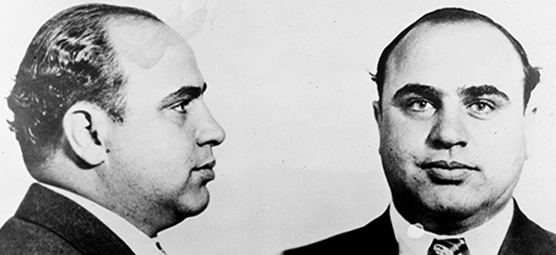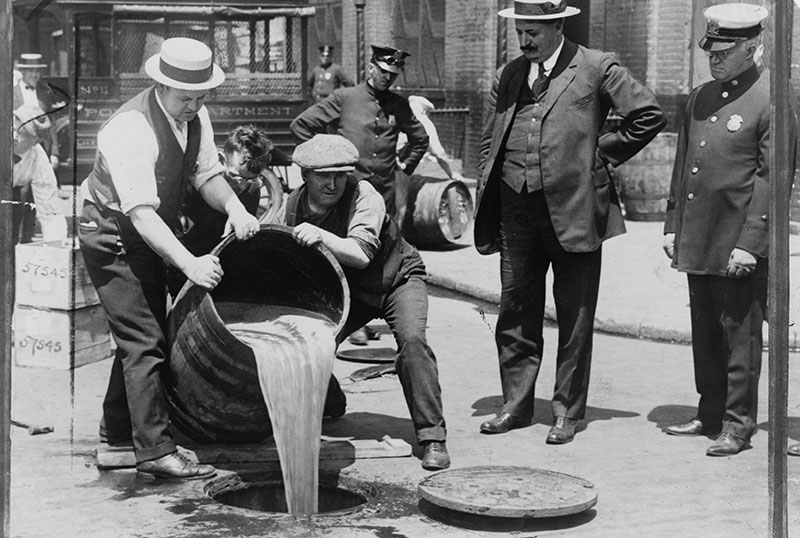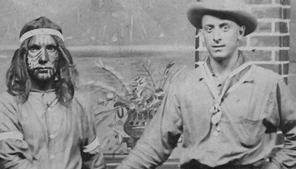Overview
The 18th Amendment to the Constitution, which banned the manufacture, distribution and sale of alcohol in America, took effect in 1920. Temperance advocates celebrated Prohibition, but so did savvy members of organized crime. Recognizing that many people still would want to imbibe, the Mob created an underground booze market. They made bootleg moonshine and beer, smuggled the good stuff into the country from Canada and the Caribbean, and opened secret saloons — called speakeasies — in cities across the country. Prohibition enforcement was meager at best. Too few federal agents and indifferent local police allowed the Mob to get rich by giving the people what they wanted.
Gallery
Keep Reading
The 18th Amendment to the Constitution, ratified in 1919, banned the manufacture and sale of alcohol. Congress then passed the Volstead Act to enforce the ban. At the stroke of a pen, centuries-old customs became illegal, dividing Americans along ethnic, regional and religious lines. Bootleggers, rum runners and the Mob seized the opportunity to, as they boasted, “Give the people what they want.”
The Prohibition Era ended in 1933 with the passage of the 21st Amendment to the U.S. Constitution. Even committed Prohibitionists had lost faith amid Mob-run bootlegging, rampant crime and open disregard for the law by drinkers. The Great Depression that began in 1929 caused waves of unemployment, federal tax revenue plunged and the government anxiously looked for a new source of revenue.
The new pro-repeal president, Franklin Roosevelt, on March 13, 1933, urged Congress to do away with Prohibition. Congress acted quickly. Ten days later, Roosevelt signed the Cullen-Harrison Act that legalized beer with 3.2 percent alcohol (up from the 0.5 percent national maximum set by Prohibition laws). In April, states started electing special conventions to consider the 21st Amendment to rescind the general ban on alcohol. Michigan was first to approve it on April 10.
The seemingly complicated process took less than nine months. On December 5, 1933, Utah’s state convention was the 36nd of the 48 states to vote wet, the three-quarters needed to end the nationwide ban on most liquor sales in the United States in effect since 1920. The 21st Amendment overturned the 18th Amendment. The new amendment took hold as of December 15, 1933. The era was officially history.
But Prohibition, born from the temperance movement of the 19th century, when alcohol abuse was widespread, has had a lasting impact on American society.
Here are some examples of Prohibition’s lasting legacy in America.

ORGANIZED CRIME
The biggest “bootleggers” in organized crime in the ’20s – among them Al Capone, Lucky Luciano, Meyer Lansky and Frank Costello – made vast fortunes thanks to their unlawful production and sale of liquor during Prohibition. The earliest bootleggers transported liquor across the Canadian and Mexican borders. Mobsters monopolized the operations from concealed distilleries to storage to distribution to consumption. The large profits coming in created rivalries and feuds between the various gangs, often ending in violence. The most infamous of these was The St. Valentine’s Day Massacre on February 14, 1929, in Chicago. Seven members of Bugs Moran’s gang were lined up against a brick wall and shot to death by assassins allegedly associated with Al Capone’s gang. The brick wall from that Massacre is found on the third floor in the Museum. After repeal, mobsters invested their ill-gotten proceeds. Some, such as New Jersey kingpin Longie Zwillman, went into the legal booze business. Others turned to the usual Mob rackets of illegal gambling, prostitution, loan sharking, narcotics and murder-for-hire. They also bankrolled various legitimate businesses, notoriously furnishing the seed money that practically created Las Vegas and its multibillion-dollar casino tourism industry. Las Vegas casinos were a source of millions in illicit “skimmed” cash for various Mafia families well into the 1970s.
WOMEN’S RIGHTS
The unprecedented impact of women on the temperance movement that began in the 19th century led not only to Prohibition but women’s suffrage. Women’s rights activists such as Susan B. Anthony, Amanda Bloomer and Lucy Stone started out in the anti-alcohol movement. That drive no doubt propelled the states, only a year after enacting Prohibition, to pass the 19th amendment granting women the right to vote nationally in 1920.

FLAPPERS AND SPEAKEASIES
The 1920s saw the demise of the male-oriented saloon and the explosion of illegal “speakeasy” bars and jazz clubs where young women for the first time were seen drinking in public with men. It was the period labeled the Jazz Age or the Roaring ’20s, known for the glamorous, carefree “flapper.” Women, who now had the right to vote, rejected the last vestiges of Victorianism and were free to hold progressive views about fashion, sexuality and the so-called vices.
CONSTITUTIONAL HISTORY
Prohibition’s repeal was a remarkable historical event in the annals of American constitutional law. It was the first and only time the Constitution was amended by state constitutional conventions – instead of state legislatures – and the only time an amendment abolished a previous one.
AMERICANS DRINK LESS LIQUOR THAN BEFORE PROHIBITION
Before Prohibition began in 1920, the average American drank 2.6 gallons of alcohol each year. That average, even with speakeasies and the bootlegged liquor, fell drastically, by more than seventy percent, in the early years of Prohibition. After its abolition, Americans did not return to the pre-Prohibition drinking level until 1973. Since the mid-1980s, annual consumption has fallen to about 2.2 gallons per person. The United States does not even make the list of the top ten countries with the highest consumption of liquor (Luxembourg, at 4.11 gallons per capita, is No. 1 followed by Ireland at 3.62 gallons and Hungary at 3.59 gallons).
THE PROHIBITION PARTY
Formed in 1869 to elect politicians opposed to alcoholic beverages, the Prohibition Party is still America’s oldest third party. It was the first political party to permit women as members. Thomas Nast, the famed cartoonist for Harper’s Weekly in the late 1800s who created the elephant to symbolize the Republican Party and the donkey for Democrats, settled on the camel for the Prohibition Party, since that animal drinks only water. The “dry” party once packed a punch. Party historians believe the group’s votes hurt the Republicans so much at the polls in the 1914 and 1918 presidential elections that the GOP backed Prohibition in 1919 to neutralize it. In 1916, the party’s candidate for the governor in Florida, Sidney Catt, was elected to serve one term. But though it may have had some influence long ago, the Prohibition Party is today little more than a curiosity with very little support left. Its candidate for president garnered a measly 519 votes nationwide in 2012.

IT’S HARDER TO FIND A DRINK THAN DURING PROHIBITION
The 21st Amendment essentially shifted regulation of the production, sales and distribution of alcohol from the federal government to the states. Whereas drinking illegally in speakeasies or elsewhere during Prohibition was unfettered and free, state regulation has in effect made it more difficult to drink. The states passed a variety of laws limiting the hours of operation and locations where alcohol may be sold and who may receive sales licenses. The feds retained the right to collect excise taxes on beer, wine and spirits. While it’s legal today to make wine and beer at home for personal or family use, running an old-fashioned “still” to concoct spirits or making gin in a bathtub are felony crimes under federal law. Production of distilled spirits, allowed in processing plants, is strictly regulated by the Alcohol and Tobacco Tax and Trade Bureau of the U.S. Treasury Department. And there are still dozens of “dry” counties in the United States – or “moist,” with some of their cities wet – mainly in the Midwestern and Southern Christian “Bible Belt.”
ALCOHOLICS ANONYMOUS
In 1934, Bill Wilson, who drank heavily during Prohibition and compounded his problem after its repeal, entered a detoxification program in Manhattan for the third time. While undergoing treatment, he joined a Christian movement called the Oxford Group. During a meeting of the group in Ohio, he met a follow alcoholic named Dr. Robert Smith. Wilson convinced Smith that the only way to serve God was abstinence. Smith finally agreed to sobriety on June 10, 1935, considered the day of the founding of Alcoholics Anonymous, a nationwide organization named after Wilson’s book of the same name. Wilson created AA’s famous “12-step” program. Alcoholics Anonymous has about 1.2 million followers (who are “anonymous” and not named) and 55,000 chapters nationwide.
LIQUOR IS ONE OF THE HIGHEST-TAXED INDUSTRIES
One vestige of the post-Prohibition years is taxing alcohol at a hefty rate as a target of “sin taxes” along with tobacco. The combination of federal, state and local taxes on legal hooch make up fully half the price of each bottle of alcohol that consumers purchase. In 2014, the feds took in $7.9 billion in federal excise taxes on liquor, which by U.S. estimates is a $400 billion to $500 billion per year industry employing about four million people. The states brought in about $6.1 billion in alcohol taxes that year.















